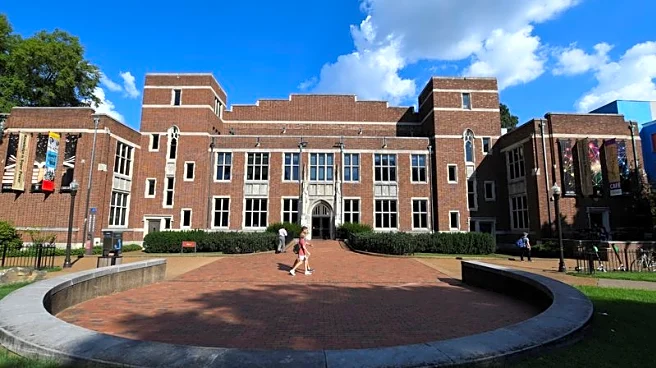What is the story about?
What's Happening?
President Trump's Department of Education has initiated negotiations to overhaul student-loan repayment plans, focusing on new income-driven repayment options and caps on borrowing. The proposed changes include eliminating the Grad PLUS loan program, which currently allows graduate and professional students to borrow up to the full cost of attendance. Instead, new borrowing caps are suggested: $20,500 annually and $100,000 lifetime for graduate students, and $50,000 annually and $200,000 lifetime for professional students. The higher cap for professional degrees is limited to ten specific programs, raising concerns among negotiators about the exclusion of other critical fields such as clinical psychology and engineering. The department aims to curb excessive borrowing, but experts warn this could lead students to seek private loans or reconsider enrollment.
Why It's Important?
The proposed changes to student loan repayment plans could significantly impact the financing of advanced degrees in the U.S. By capping federal borrowing, students may face increased reliance on private loans, potentially leading to higher interest rates and financial burdens. This shift could deter individuals from pursuing graduate and professional education, affecting workforce development in crucial sectors like mental health and engineering. The overhaul aims to simplify repayment systems and reduce student debt, but the exclusion of certain programs from higher borrowing caps may hinder access to necessary education for many students, impacting their career prospects and the broader economy.
What's Next?
Further negotiation sessions are scheduled for November, with the final implementation of changes expected by July 2026. The Department of Education is open to discussing modifications to the list of programs eligible for higher borrowing caps, though significant changes are unlikely in the current negotiation round. Stakeholders, including educational institutions and state departments, may continue to advocate for broader inclusion of programs critical to economic and workforce development. Prospective students and colleges will need to navigate these changes as they plan for future academic years, potentially adjusting tuition rates or seeking alternative funding sources.
Beyond the Headlines
The proposed student loan changes highlight broader issues in the U.S. education system, including the balance between federal support and private lending. The exclusion of certain programs from higher borrowing caps raises ethical questions about equitable access to education and the prioritization of specific fields over others. Long-term, these changes could influence the landscape of higher education, prompting institutions to reassess tuition structures and financial aid offerings. The focus on reducing student debt aligns with broader fiscal policy goals, but the potential impact on educational access and workforce readiness remains a critical concern.
AI Generated Content
Do you find this article useful?














